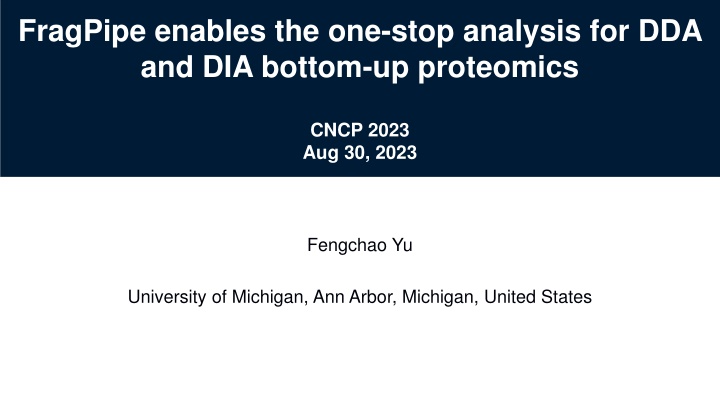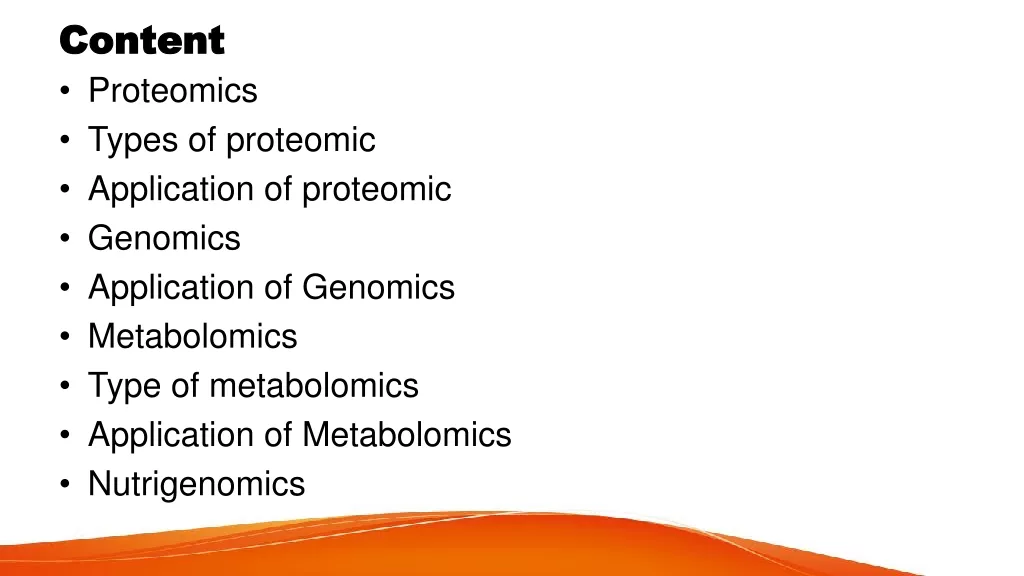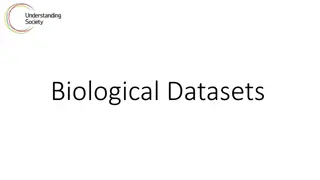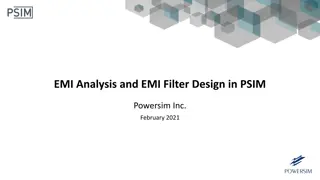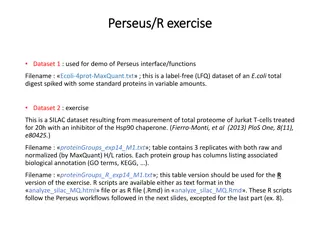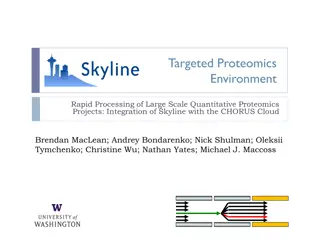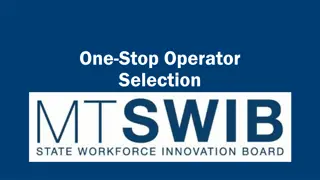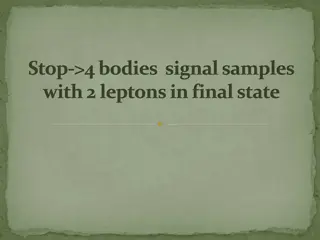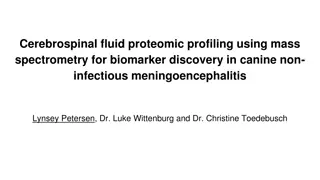FragPipe: One-Stop Proteomics Data Analysis Suite
FragPipe offers a comprehensive solution for DDA and DIA bottom-up proteomics analysis, supporting various advanced functionalities such as closed and open searches, FDR estimation, PTM discovery, and label-free quantification. It simplifies deep-learning-based rescoring and provides an easy-to-use GUI interface for efficient peptide identification and quantification in proteomics research.
Download Presentation

Please find below an Image/Link to download the presentation.
The content on the website is provided AS IS for your information and personal use only. It may not be sold, licensed, or shared on other websites without obtaining consent from the author.If you encounter any issues during the download, it is possible that the publisher has removed the file from their server.
You are allowed to download the files provided on this website for personal or commercial use, subject to the condition that they are used lawfully. All files are the property of their respective owners.
The content on the website is provided AS IS for your information and personal use only. It may not be sold, licensed, or shared on other websites without obtaining consent from the author.
E N D
Presentation Transcript
FragPipe enables the one-stop analysis for DDA and DIA bottom-up proteomics CNCP 2023 Aug 30, 2023 Fengchao Yu University of Michigan, Ann Arbor, Michigan, United States
Data acquisition and analysis in bottom-up proteomics Aebersold and Mann, Nature (2016)
FragPipe is becoming one-stop proteomics data analysis suite FragPipe supports: Closed and open searches FDR estimation Glycopeptide search Deep-learning-based rescoring PTM discovery Spectral library building Label-free quantification Isotopic-labeled quantification Isobaric-labeled quantification DIA peptide identification and quantification
Deep-learning-based prediction How to use deep-learning-based prediction in peptide identification? 1. Generate a spectral library from the whole database The spectral library can be reused Predicting the whole database is slow PTMs and non-specific digestion make it too slow to be used in practice 2. Rescore the PSMs after database searching Most tools require GPU Most tools require Python or upload to webserver. There is no easy-to-use GUI interface
An ideal rescoring software Most users do not have powerful NVIDIA GPUs CPU only Fast Installing Python packages is not always easy No additional installation Plug and play (distributed with FragPipe) Command line interface is not user friendly Easy-to-use GUI (FragPipe)
HLA rescoring Yang et al., Nat. Commun. (2023)
timsTOF HeLa tryptic search rescoring Yang et al., Nat. Commun. (2023)
DIA data analysis In silico/experimental spectral library based Easy to implement Easy to get good results from tryptic proteome data with common PTMs Many tools have been developed Time consuming Developing another tool is BORING Feature extraction and pseudo-MS/MS based Sensitivity is low Slow
DIA data analysis 92 Human lymph nodes (real patient heterogeneity) + spike-in E. coli peptides E. coli to Human ratio NA 1/06 vs 1 1/12 vs 1 1/25 vs 1 Data type Condition name Lymphnode 1-06 1-12 1-25 #Samples 23 23 23 23 Mixture Human lymph node only Human lymph node + E. coli Human lymph node + E. coli Human lymph node + E. coli Pooled samples, 6 fractions Pooled samples, high-pH perfectionated, 2 10 fractions Single-shot DIA GPF-DIA DDA Fr hlich et al., Nat. Commun. (2022) Fr hlich et al., Nat. Commun., (2022) Result label Spectronaut 14 Spectronaut 17 Tools Data Approach directDIA directDIA+ Spectronaut 14 Spectronaut 17 Single-shot DIA Library free (in-silico library prediction) DIA-NN lib-free DIA-NN 1.8.1 FP-MSF FP-MSF hybrid FragPipe 18.0 + MSFragger 3.5 Library free Single-shot DIA + GPF DIA + DDA
DIA data analysis Tool E.coli precursors 1497 1337 267 414 459 H. Sapiens precursors 48390 86720 64846 68883 82155 ratio (%) 3.094 1.542 0.412 0.601 0.559 Spectronaut 14 Spectronaut 17 DIA-NN lib-free FP-MSF FP-MSF hybrid Yu et al., Nat. Commun. (2023)
DIA data analysis Yu et al., Nat. Commun. (2023)
DIA data analysis E. coli to Human ratio Condition name #Samples Mixture Lymphnode 23 Human NA Human + E. coli 1-06 23 1/06 vs 1 Human + E. coli 1-12 23 1/12 vs 1 Human + E. coli 1-25 23 1/25 vs 1 Yu et al., Nat. Commun. (2023)
DIA data analysis E. coli to Human ratio NA 1/06 vs 1 1/12 vs 1 1/25 vs 1 Condition name Lymphnode 1-06 1-12 1-25 #Samples 23 23 23 23 Mixture Human Human + E. coli Human + E. coli Human + E. coli Yu et al., Nat. Commun. (2023)
DIA data analysis Proteome Phosphoproteome Windows desktop: Intel Core i9-10900K, 3.70 GHz, 10 cores, 20 logical processors, 128 GB of memory Yu et al., Nat. Commun. (2023)
What about comment-line interface? High performance computing clusters Webservers Processing many jobs in batches Usage: fragpipe --headless --workflow <path to workflow file> --manifest <path to manifest file> -- workdir <path to result directory> Options: -h --help # Print this help message. --headless # Running in headless mode. --workflow <string> # Specify path to workflow file. --manifest <string> # Specify path to manifest file. --workdir <string> # Specify the result directory. --dry-run # (optional) Dry run, not really run FragPipe. --ram <integer> # (optional) Specify the maximum allowed memory size. --threads <integer> # (optional) Specify the number of threads. --config-msfragger <string> # (optional) specify the location of the MSFragger jar file. --config-ionquant <string> # (optional) specify the location of the IonQuant jar file. --config-philosopher <string> # (optional) specify the location of the Philosopher binary file. --config-python <string> # (optional) specify the location of the Python directory.
Acknowledgements Nesvizhskii group: Alexey Nesvizhskii (PI) Andy Kong Guo Ci Teo Dmitry Avtonomov Sarah Haynes Daniel Polasky Daniel Geiszler Kevin Yang Ginny Xiaohe Li Kai Li Collaborators: George Rosenberger (EasyPQP) Lukas K ll (Percolator) David Shteynberg (PTMProphet) Vadim Demichev (DIA-NN) Keriann Backus Lab (UCLA) Stephan Hacker Lab (Leiden U) Ralser Lab (Francis Crick) Ying Zhu (Genentech)
Thank you Q & A
